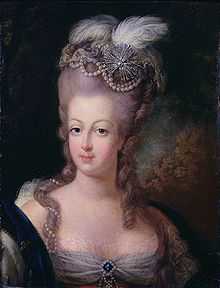Pouf

Musée Antoine Lécuyer
The pouf or pouffe is a hairstyle deriving from 18th-century France. It was made popular by the Queen of France, Marie Antoinette (1755–1793)[1] in 1774, first sporting it when she attended her husband Louis XVI's coronation, triggering a wave of young French women to wear their hair in the same manner. Marie Antoinette acquired the hair style which was a creation from the famed hairdresser of the day Léonard Autié. From then on it quickly became widespread amongst noble and upper-class women in France during the time. It was highly creative and artistic and women could literally wear their moods through strategically placed decorations and ornaments. Ships, animals and hundreds of other novelty items could be seen on these poufs. Other decorations included pearls, headdresses/hats, hair jewellery, and plumage, such as ostrich feathers. It also became popular in other countries throughout Europe and the United Kingdom during the same era, with Georgiana Cavendish, the Duchess of Devonshire the most notably famous, for her hair in Great Britain. From 1789, upon the outbreak of the French Revolution, the pouf became more of a political weapon for women who supported the revolution in turning against their former Queen's most popular fashion statement. As the 18th century came to an end, and the beginning of the 19th century, new fashions came along for hair and the pouf, after the execution of Marie Antoinette, became history. The pouf returned in both the 20th and 21st century with the more modern name "beehive", revived by stars such as Dusty Springfield, Cilla Black, Amy Winehouse and Adele.
Care
The pouf was a very delicate hairstyle and hours were needed to create it. To create the base, a very thin metal frame was used to structure the shape. It was then padded and intertwined with pomaded false hair, and one's own hair would be taken in. The pomaded hair would then be curled in various sections (varying on the specific style), with heated clay curlers. The lovelocks would be curled in a similar fashion. Once the shaping and styling was done, it would be finished off with white or grey powder, and decoration proceeded. The height varied, generally from very subtle to as much as three feet, with Marie Antoinette reportedly having worn her hair 6 ft high.
The hairstyle would remain in the wearer's hair for about a week, until it was no longer hygienic (due to the pomade) or it could no longer keep its shape, and it was then simply washed and redone. Wealthier women may have had their hair done more often than this due to the cost of the technique and materials; Marie Antoinette at one time was inventing a different hairstyle every day. Women at court found it hard to keep up with the ever changing fashion of hair. In order to keep these hairstyles from ruin, women would wear 'calashes', a type of bonnet which protected it from wind, dirt and rain. When sleeping they would add two or three pillows to keep their head upright and protect the hair. Great care was taken to duck when entering doorways and carriages, for the same reason. Candle lighting posed the additional risk of fire for tall poufs.
Popular culture
There was a brief revival of the pouf in the form of the 1960s Beehive hairstyle. Today we can see the influence of the pouf in wedding, prom, formal and commercial hairstyles where larger, teased hair has come into vogue. A recent product on the market called Bumpits has been seen, which is meant to partially shape the hair and give it lift by means of a plastic base. Television personality Nicole "Snooki" Polizzi sported a pouf in the first season of Jersey Shore. The film "Marie Antoinette" also saw a modern adaption to the pouf hairstyle as well as in "The Duchess", both movies portrayed a pouf decorated with plumes of feathers. Amy Winehouse was famed for her "Beehive" pouf hairstyle, with other singers such as British artist Adele also following the trend.
References
- ↑ Antonia Fraser